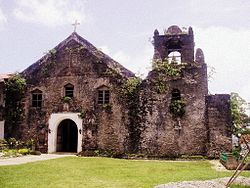- Malaueg Church
-
St. Raymond of Penyafort Malaueg Church 
The Malaueg Church during its restoration plan
Basic information Location Rizal, Cagayan, Philippines Geographic coordinates Coordinates: 17°51′0″N 121°21′0″E / 17.85°N 121.35°E Affiliation Roman Catholic State Philippines Province Cagayan Territory Poblacion, Rizal District Roman Catholic Archdiocese of Tuguegarao Year consecrated 1651 Status Malaueg Parish Church Heritage designation Cultural Website simbahan.net Architectural description Architect(s) Dominican Fathers (early 1597) Architectural type Parish Church Architectural style Stone Church General contractor Dominicans Direction of façade Eastward Completed 1608 Specifications Length 72 meters Width 27 meters Width (nave) 22 meters Height (max) 37 meters The St. Raymond of Penyafort Parish, also known as The Malaueg Church is one of the UNESCO (United Nations Educational, Scientific and Cultural Organization) world heritage sites in the Philippines and seat of The Archdiocese of Tuguegarao City, Philippines. The church dedicated to San Raymundo de Penaforte was built in Malaueg through the efforts of a local chieftain named Luis Pagulayan. Malaueg was accepted as an ecclesiastical mission of the Dominicans in 1608 and was used as an outpost for the conquest of the Cordillera and in bringing down remontados. During a rebellion led by Caguenga and Furuganan from 1608 to 1610, the convent of the church was razed by fire. Fr. Francisco Mola (OP) built another church in 1617 that was destroyed by fire in 1641. The present church that, in a time, was the biggest built in Cagayan Valley was blessed on 1651. Famous Dominicans served in the mission of Malaueg namely Fr. Jose Bugarin (OP) who was the principal author of the first Ibanag dictionary, Fr. Luis Flores (OP) who became a martyr in Japan, and Fr. Francisco Capillas who became a pro-martyr in China. The church represents an early effort at stone church building.
Contents
Physical Features
The church as seen today is entirely botanical. It's corners were entirely covered with plants, the front area was also covered with plants. By the inspections of the Engineers, the church was entirely made of "Sedimentary rocks" or "smooth river stones". Even the church's back part was entirely covered with botanical plants. The bell tower was holding one of the oldest church bell in the Philippines. It was stolen by unrecognized idea.
A programme of cleaning and restoration of the Stone Church was carried out 2009-present. The clearing of Botanical plants at the facade was completely a success also with the re-paint of Church roof, ceilings and inside walls. also with the re-construction of the ladder to the bell tower. The restoration was started through the generosity of the faithfuls in and outside the parish. The request was made during the term of Rev. Macario Malano Jr.(2005-2011) parish priest of the parish church.
Inside Features
The church was made entirely with smooth river stones but in the inside has the same age with the outer walls. Inside also features a centuries year old altar with the statue of St. Raymond de Penyafort at the center, Jesus Christ at the left side, Mother Mary and the child Jesus at the right and the Crucifixion of Jesus Christ at the top. The altar was often infested by Bats.
Church Ruins
At the Church far back, the early ruins still visible. Even the early church facade is still visible. At the area, some engineers discovered crosses known to be as the early Spanish cemetery and was still visible. Also the church's way of the cross. It was rumored that the wooden way of the cross does rumors that have been discovered by Malaueg people. The early convent was now turned to a private school. Until today, the old convent ruins is still visible that it was also made entirely with "River Stones".
Church Rumors
The church was old, many known Spanish priest were buried at the back part of the church. Many rumors were told about treasures of these Spanish priests. Some says that when in a dream, there's a gold to be dug deep. Some people believe on the rumors because it happens when one of the citizens dreamed about a treasure at the rear part of the church. These "Malaueg" people tell this rumors then some came true.
Traditions
The Feast of the St. Raymond De Penyafort is observed on 23 January in the town.
External links
Categories:- Roman Catholic churches in the Philippines
Wikimedia Foundation. 2010.
